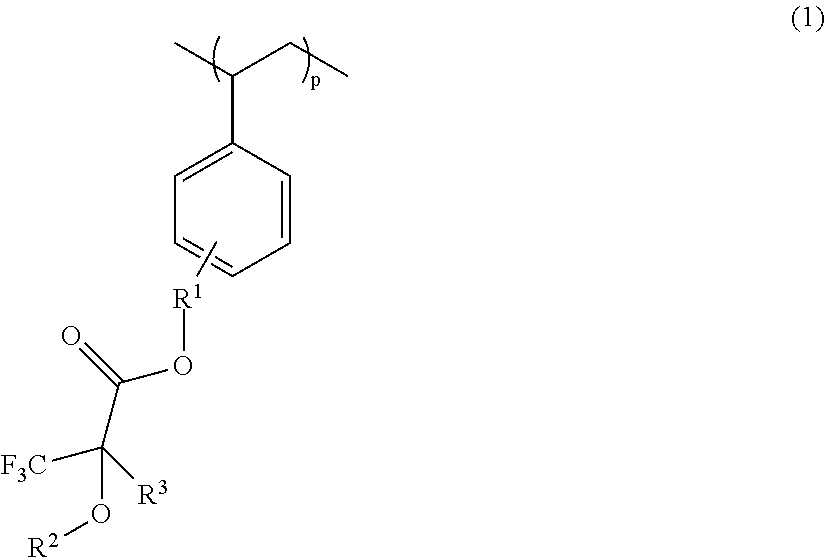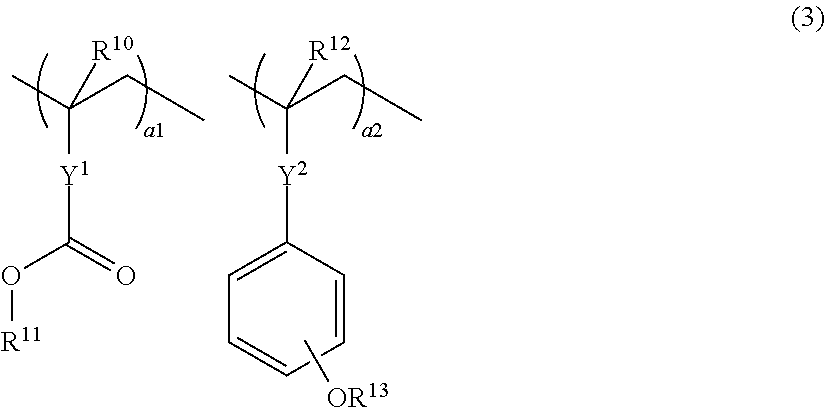Resist composition, patterning process and polymer
a technology of resist composition and patterning process, applied in the field of resist composition, can solve the problems of reducing throughput, reducing reflectivity, and dimensional error of masks that affect the dimensional variation of patterns, etc., and achieve the effect of suppressing the formation of blob defects and reducing edge roughness
- Summary
- Abstract
- Description
- Claims
- Application Information
AI Technical Summary
Benefits of technology
Problems solved by technology
Method used
Image
Examples
synthesis example 1
[0165]A 2-L flask was charged with 32.8 g of Monomer 1 and 40 g of tetrahydrofuran as solvent. The reactor was cooled to −70° C. in a nitrogen atmosphere, whereupon vacuum evacuation and nitrogen blow were repeated three times. The reactor warmed up to room temperature whereupon 1.2 g of azobisisobutyronitrile (AIBN) was added as a polymerization initiator. The reactor was heated at 60° C. and reaction run for 15 hours. The reaction solution was precipitated from 1 L of isopropyl alcohol. The white solid was collected by filtration and dried in vacuum at 60° C., yielding a white polymer.
[0166]The polymer was analyzed by 13C-NMR, 1H-NMR, and GPC, with the analytical data shown below.
Copolymer composition (molar ratio)
[0167]Monomer 1=1.0 (indicative of homopolymer)
Mw=8,100
Mw / Mn=1.85
[0168]This is designated Polymer 1.
synthesis example 2
[0169]A 2-L flask was charged with 16.4 g of Monomer 1, 5.2 g of styrene, and 40 g of tetrahydrofuran as solvent. The reactor was cooled to −70° C. in a nitrogen atmosphere, whereupon vacuum evacuation and nitrogen blow were repeated three times. The reactor warmed up to room temperature whereupon 1.2 g of AIBN was added as a polymerization initiator. The reactor was heated at 60° C. and reaction run for 15 hours. The reaction solution was precipitated from 1 L of isopropyl alcohol. The white solid was collected by filtration and dried in vacuum at 60° C., yielding a white polymer.
[0170]The polymer was analyzed by 13C-NMR, 1H-NMR, and GPC, with the analytical data shown below.
Copolymer composition (molar ratio)
[0171]Monomer 1:styrene=0.5:0.5
Mw=9,900
Mw / Mn=1.98
[0172]This is designated Polymer 2.
synthesis example 3
[0173]A 2-L flask was charged with 16.4 g of Monomer 1, 4.2 g of styrene, 2.7 g of trans-stilbene and 40 g of tetrahydrofuran as solvent. The reactor was cooled to −70° C. in a nitrogen atmosphere, whereupon vacuum evacuation and nitrogen blow were repeated three times. The reactor warmed up to room temperature whereupon 1.2 g of AIBN was added as a polymerization initiator. The reactor was heated at 60° C. and reaction run for 15 hours. The reaction solution was precipitated from 1 L of isopropyl alcohol. The white solid was collected by filtration and dried in vacuum at 60° C., yielding a white polymer.
[0174]The polymer was analyzed by 13C-NMR, 1H-NMR, and GPC, with the analytical data shown below.
Copolymer composition (molar ratio)
[0175]Monomer 1:styrene:trans-stilbene=0.5:0.4:0.1
Mw=7,200
Mw / Mn=1.98
[0176]This is designated Polymer 3.
PUM
| Property | Measurement | Unit |
|---|---|---|
| wavelength | aaaaa | aaaaa |
| wavelength | aaaaa | aaaaa |
| wavelength | aaaaa | aaaaa |
Abstract
Description
Claims
Application Information
 Login to View More
Login to View More - R&D
- Intellectual Property
- Life Sciences
- Materials
- Tech Scout
- Unparalleled Data Quality
- Higher Quality Content
- 60% Fewer Hallucinations
Browse by: Latest US Patents, China's latest patents, Technical Efficacy Thesaurus, Application Domain, Technology Topic, Popular Technical Reports.
© 2025 PatSnap. All rights reserved.Legal|Privacy policy|Modern Slavery Act Transparency Statement|Sitemap|About US| Contact US: help@patsnap.com



